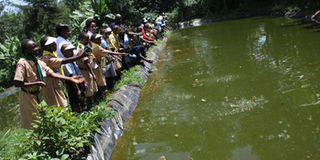What you need to know on candling an egg

Teachers and pupils at Harti School in Gatundu near the fish pond on February 2, 2016. Most private schools in Gatundu are practising fish farming. The management says it enables pupils to learn farming skills at a tender age. PHOTO | ANTHONY OMUYA
What you need to know:
- Candling of eggs should be done on the 7th and 14th day of incubation. On the 7th day, clear eggs indicate infertility, red blood vessels (resemble tree branches) indicate fertile eggs while red or black staining and blood rings indicate early death at this point.
- I am based in Kitui, and I tried keeping 150 layers but after five months I discovered that they were cockerels. I kindly request that you guide me because I want to start again this time with 2,000 layers.
MAXIMISING PROFIT FROM POULTRY
I like the speed at which broilers mature. I would like to know what the profit will be from about 200 broilers. What should I do to maximise profits?
David Bor, Kericho
Production of broilers may take six to eight weeks depending on the market weight requirement. If your production period is eight weeks, producing each bird on average will cost Sh174.
To maximise your profits, first determine the market weight requirement then reduce the production cycle period to six weeks during which the birds should be given feeds with high protein content in the first three weeks and high energy content in the last three weeks as this has a positive influence on body weight in a shorter period.
Sophie Miyumo,
Animal Sciences Department, Egerton University.
ALL ABOUT CANDLING
Kindly enlighten me on the following in candling of eggs:a) After how many days of incubation do you candle an egg?b) What features do you check when candling to differentiate between fertilised and unfertilised egg?c) Where can you get a candling light?
Anwar Ahmed
Candling of eggs should be done on the 7th and 14th day of incubation. On the 7th day, clear eggs indicate infertility, red blood vessels (resemble tree branches) indicate fertile eggs while red or black staining and blood rings indicate early death at this point.
On the 14th day, eggs that are three-quarters completely dark from the narrow end and a quarter clear at the broad end (air sac space) indicate that the embryo is developing while a dark outline with ill-defined detail indicates late death of the embryo.
Refrain from candling after day 16 as the eggs should not be moved or turned days prior to hatching. The candling equipment usually looks like a small flashlight powered by either batteries or plug-in cord and can be sourced from incubator suppliers.
Sophie Miyumo,
Animal Science Department, Egerton University.
I NEED LAND TO LEASE
I am Charles from Nakuru County. I want to engage in some farming but the problem is that I have no land. Do you know any land for leasing by the central government, Nakuru County government, Kenya Wildlife Service or the Kenya Forest Service in my area and if so, how much does it cost to lease and any other relevant information I should know?
Government land is available, however, there are restrictions, rules and regulations that you must adhere to, for example, when you lease land from the forestry service, you will be required to take care of young trees up to about four or five years.
You will also not be able to grow crops that deplete the trees of the natural resources and you should practice soil and water conservation. In some cases, you will be required to be in a group for accountability purposes and training services.
Remember these parcels are in different places and the choice will affect what you would want to grow. Further, land from the government is normally open land and thus difficult to put up permanent structures such as terraces, trees and fences for security against trespassers and animals.
For more information, visit the Nakuru County government offices, especially the agriculture offices.
Muriuki Ruth Wangari and Peter Caleb, Department of Crops, Horticulture and Soils, Egerton University.
I wish to start a poultry farm
I am based in Kitui, and I tried keeping 150 layers but after five months I discovered that they were cockerels. I kindly request that you guide me because I want to start again this time with 2,000 layers.
1. What is the best breed for layers?
2. The most reliable sources of chicks in the market
3. In case of power blackout, how do I maintain heat supply? (I had a mortality of 30 chicks previously)
Catherine
There are several hatcheries in Kenya producing day-old layer chicks, but you should consider the reputation of the enterprise before buying the chicks to avoid such problems like sex mix-up or poor quality chicks.
The following are some of the leading hatcheries in Kenya and the layer breeds they produce: Kenchic Ltd. - Issa Brown breed, Muguku Poultry Farm - Shaver Brown and Sigma Supplies Ltd - Lohman Brown Classic.
All these breeds are good layers that can reach a peak of 80–85 per cent of egg production but this is highly dependent on your management.
In case of a blackout, use a jiko covered with a hoover (metallic - resembles an umbrella) to allow heat to spread throughout the brooder and ensure the jiko is slightly raised to prevent the chicks from gaining access.
Sophie Miyumo,
Department of Animal Sciences, Egerton University.




